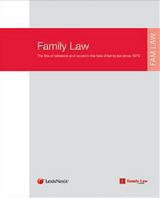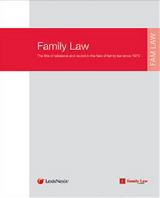family law, reforms, legal aid, LASPO, exceptional funding, single family court, family justice review
Jo Edwards, Chair, Resolution and Susan Jacklin QC, Chair, Family Law Bar AssociationThe biggest set of changes to the family justice system in a generation are starting to take effect. We caught up with the chairs of the two most directly affected membership bodies to hear their reports from the frontline.
Three months on, what positive impacts are your members seeing from the 22 April changes?
Susan: The introduction of a single Family Court that replaces the three tiers of court for family cases has been very positive and was long overdue. This was bound to be a good thing. It is providing a joined-up approach that the family courts previously lacked.
Jo: I agree, a single Family Court has been extremely positive. We welcomed the proposal for a unified family court when Sir David Norgrove recommended it in the Family Justice Review in 2011. The gatekeeping function, for example, means that courts are looking more robustly at Mediation Information and Assessment Meetings (MIAMs) and at mediation as an option. Of course, it’s very early days, so it’s hard to identify trends. We plan to survey Resolution’s members regularly, probably quarterly, for feedback. Where systemic problems are identified, we will then engage with the President of the Family Division.
What else is working particularly well?
Jo: Just this week, I made my first visit since the 22 April changes to the Central Family Court in London. In administration terms, it was an extremely positive and much improved experience. It was a lot more user friendly, from the helpfulness of security staff (including when I took a wrong turn myself!) through to the provision of information for litigants in person. This is not necessarily the case across the country, but in central London it was a notable change. A more welcoming layout and approach can make a big difference to litigants in person, who may be feeling intimated and overwhelmed.
Susan: The introduction of a 26-week time limit for completing care cases has largely gone well, with judges being more efficient in their case management. Although it wasn’t until 22 April that it became a legal requirement for public law applications to be completed within 26 weeks, the reality was that judges were applying the spirit of s14 of the Children and Families Act for the previous six to ten months. It has been a smooth transition. It has also become apparent that 26 weeks is not a rigid rule and the timeframe will be extended when necessary in the interests of the child.
What have been the major challenges or stumbling blocks?
Susan: Unfortunately the changes were introduced following a year of dealing with the consequences of LASPO (the Legal Aid, Sentencing and Punishment of Offenders Act 2012) and the cuts to legal aid. Members of the FLBA are witnessing daily the adverse effects of LASPO – including lack of legal advice, lack of representation and lack of funding for expert reports. Meanwhile, different teething problems appear to be emerging in different parts of the country. In some places, magistrates are overloaded and taking too long to decide cases; elsewhere we are seeing local authorities delaying the issue of proceedings.
Jo: Inevitably there have been some teething problems. The new child arrangement forms are convoluted and hard to work with, for example. The courts seem to be facing difficulties with standard orders. Since LASPO was introduced, we have seen significant rises in litigants in person – and the reality of more separating people than ever before representing themselves is presenting real challenges for judges. It’s also the case that many local authorities think they can’t complete care cases in 26 weeks, though most are working hard to do so.
To what extent are the issues being encountered a result of the 22 April changes?
Susan: The rise in litigants in person would be happening anyway. The same goes for the lack of availability of experts – their fees have been cut, and the work can be onerous and time-consuming, so they feel that it is not worth their while. We are seeing vulnerable litigants in person who are not entitled to public funding and are unable to get necessary expert assessments.
Jo: While the 22 April changes are a result of the Family Justice Review, we have also been hit by LASPO along the way. There has been huge change for our members to cope with and many are understandably at saturation point. An area of particular concern is a dip in publicly funded mediation. Justice minister Simon Hughes MP is looking at this. This is an inevitable result of LASPO and the removal of solicitors and Citizens Advice Bureaux from the equation, and it is a huge tragedy.
What changes are you seeing now that separating couples have to attend MIAMs before making an application to the court?
Jo: Overall, ensuring that separating couples find out more about non-court options is hugely welcome. As a mediator myself though, I think it’s important to remember that mediation is not a panacea. It doesn’t always work, and some cases need a judge. I have been acting for a client in a children case that has involved eight mediation sessions with two mediation services, roundtable discussions and solicitors’ correspondence, but nevertheless we are stuck and mediation hasn’t worked. In that situation, it isn’t helpful then for the parents to be faced with a judge telling them that two such intelligent parents should be able to resolve this without court involvement. For parents who are stuck in this way, they still need a judge.
Susan: That’s a good point. Such parents are at risk of being forgotten. Mediation is usually the most constructive way to resolve disputes about the most beneficial arrangements for children after relationship breakdown. In my experience, Resolution solicitors will always try to suggest mediation when appropriate. But there has to be recognition by judges that some cases will simply not be resolved by mediation.
What are your hopes for the future?
Susan: There needs to be a change in the guidance in respect of s10 of LASPO, so that it is in line with the European Convention on Human Rights. On a daily basis we are seeing cases which ought to attract exceptional funding under s10. The task of dealing with litigants in person who have not received any legal advice is difficult enough for judges. But dealing with cases involving serious allegations against unrepresented respondents or litigants with mental health difficulties but no funding to provide medical advice, for example, is making their task almost impossible in terms of concluding cases justly and with minimum delay.
Jo: Resolution endorses all of that. Section 10 is not providing the safety valve that it should be doing. We are working tirelessly to collate evidence of injustice – to put flesh on the bones of our concerns when we see people being denied access to justice. Looking further ahead, Resolution hopes to play a greater role in helping to develop the future of family law, and to be more involved in shaping future reforms. The President of the Family Division has made significant and welcome strides to improve communications with practitioners. Hopefully we can build on that, and we are keen to combine our voice with that of the Family Law Bar Association in doing so.
This interview was originally published in the July/August issue of The Review and can be accessed on the Resolution website. It has been reproduced here with permission of the copyright owner.












 3 FEB 2025
3 FEB 2025

 3 FEB 2025
3 FEB 2025

 3 FEB 2025
3 FEB 2025

 3 FEB 2025
3 FEB 2025

 3 FEB 2025
3 FEB 2025












Leave a commentOrder by
Newest on top Oldest on top